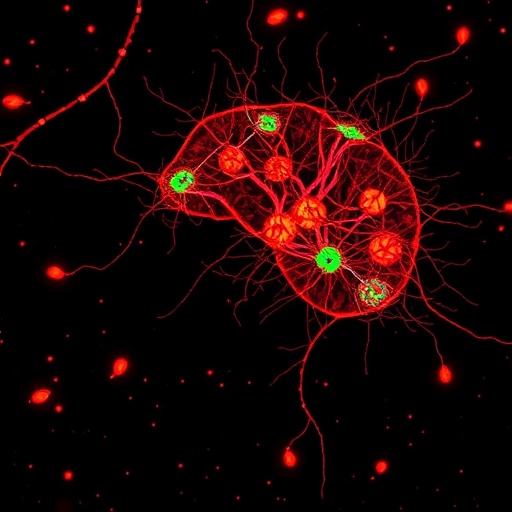In a groundbreaking new study published in Cell Death Discovery, researchers have uncovered a crucial link between the loss of the protein Ezrin and catastrophic neuronal cellular dysfunction, illuminating a novel pathway that converges mitochondrial failure with oxidative stress, ultimately culminating in neuronal cell death. This discovery, poised to reshape our understanding of neurodegenerative disease mechanisms, hinges on the pivotal role of Ezrin, a cytoskeletal organizer previously underappreciated in neuronal biology. The research not only bridges gaps between cytoskeletal integrity and mitochondrial health but also throws open doors for fresh therapeutic strategies targeting neurodegeneration.
Ezrin, a member of the ERM (Ezrin-Radixin-Moesin) family of proteins, is classically recognized for its ability to link the plasma membrane to actin filaments. However, this new study by Giamundo and colleagues reveals an unsuspected mitochondrial dimension to Ezrin’s function in neurons. Their meticulous work demonstrates that the depletion or loss of Ezrin disrupts mitochondrial dynamics and function, provoking extensive oxidative stress within neuronal cells. This oxidative accumulation then precipitates an irreversible cascade driving cell death, a hallmark of many neurodegenerative disorders.
Mitochondria, beyond their well-known role as cellular powerhouses, act as regulators of apoptosis and oxidative balance. The research uncovers that upon Ezrin loss, mitochondrial morphology shifts profoundly toward a fragmented and dysfunctional state. This morphology collapse is tightly coupled with a drop in mitochondrial membrane potential, compromising ATP production and increasing reactive oxygen species (ROS) production. Such ROS surge overwhelms the cell’s antioxidant defenses, leading to oxidative damage of essential biomolecules including DNA, lipids, and proteins.
The study employed advanced imaging techniques alongside biochemical assays to precisely map the lethal trajectory initiated by Ezrin depletion. High-resolution fluorescence microscopy revealed that mitochondria in Ezrin-deficient neurons lost their normal tubular network, becoming punctate and swollen. Complementary assays measuring mitochondrial respiratory capacity showed significantly impaired oxygen consumption rates, indicating a severe energetic crisis. This mitochondrial dysfunction occurred concomitantly with enhanced indicators of oxidative stress, such as elevated levels of oxidized glutathione and lipid peroxidation products.
One of the striking aspects of this study is the clear demonstration that Ezrin connects cytoskeletal integrity to mitochondrial health, suggesting that the structural scaffold provided by Ezrin is essential for maintaining mitochondrial architecture and function in neurons. Loss of Ezrin appears to sever this critical link, disrupting mitochondrial positioning and dynamics, which are vital for neuronal survival given the high energetic and metabolic demands of these cells.
The research team explored the downstream molecular events triggered by increased oxidative stress following Ezrin loss. They identified activation of apoptotic signaling pathways, including upregulation of pro-apoptotic markers like Bax and activation of caspase enzymes. This apoptotic cascade ultimately culminates in neuronal death, offering a direct mechanistic explanation for neurodegenerative patterns observed in conditions associated with cytoskeletal abnormalities.
Importantly, the researchers highlighted that the observed mitochondrial and oxidative stress dysfunction is not merely a bystander effect but a driving force of neuronal demise. They demonstrated that pharmacological restoration of mitochondrial function or antioxidant treatment could partially rescue neuronal survival, underscoring the therapeutic potential of targeting these downstream effects.
While much prior research has focused on mitochondrial dysfunction or oxidative stress independently in neurodegeneration, this study elegantly ties these phenomena together through the lens of Ezrin loss. It thus integrates cytoskeleton biology with mitochondrial and oxidative stress pathways, providing a multifaceted perspective on neuronal vulnerability.
The implications of these findings extend beyond fundamental neuroscience, offering potential translational avenues. Therapeutic strategies that stabilize Ezrin expression or function might halt or slow down disease progression in disorders marked by neuronal cytoskeletal and mitochondrial impairments. Moreover, antioxidants or mitochondrial-targeted therapies could serve as adjunct treatments to mitigate oxidative damage initiated by Ezrin destabilization.
This study also raises tantalizing questions about Ezrin’s exact mechanistic roles at the mitochondrial interface. Whether Ezrin directly interacts with mitochondrial proteins or modulates signaling pathways that govern mitochondrial biogenesis and quality control remains to be clarified. Future research will undoubtedly dive deeper into how Ezrin orchestrates these essential cellular processes.
Additional exciting frontiers include exploring Ezrin’s involvement in synaptic function given mitochondria’s critical role in neurotransmitter release and calcium buffering at synapses. Disruption of Ezrin could contribute to synaptic failure seen in early stages of neurodegenerative diseases, making it an appealing target for early intervention.
Equally important is the potential that Ezrin expression levels or mitochondrial morphology signatures might serve as biomarkers for disease diagnosis or progression monitoring. This would enhance clinical evaluation and personalization of treatments for neurodegenerative conditions.
Altogether, this pioneering work by Giamundo et al. represents a major leap forward in understanding the complex interplay between cytoskeletal dynamics, mitochondrial health, oxidative stress, and neuronal viability. It underscores the multifactorial nature of neurodegeneration and the necessity to approach its mechanisms from integrated biochemical and structural perspectives.
As neurodegenerative diseases continue to pose immense clinical challenges, breakthroughs such as these offer hope for unraveling the intricate molecular web that underlies neuronal death. The findings advocate for a paradigm shift where proteins like Ezrin, previously considered mere structural components, are recognized as central guardians of neuronal survival through their governance of mitochondrial function and oxidative homeostasis.
Ultimately, these insights pave the way for novel, mechanism-based therapeutic development aimed at preserving the integrity of neurons—the very foundation of cognition and motor function. In capturing the critical role of Ezrin, this research opens avenues toward a future where neurodegeneration can be more effectively combated, improving millions of lives worldwide.
Subject of Research: Loss of Ezrin impacts neuronal mitochondria and oxidative stress, leading to neuronal cell death.
Article Title: Loss of Ezrin triggers mitochondrial dysfunction and oxidative stress, associated with neuronal cell death.
Article References:
Giamundo, G., Carratù, I., Barone, C. et al. Loss of Ezrin triggers mitochondrial dysfunction and oxidative stress, associated with neuronal cell death. Cell Death Discov. 11, 490 (2025). https://doi.org/10.1038/s41420-025-02790-5
Image Credits: AI Generated




